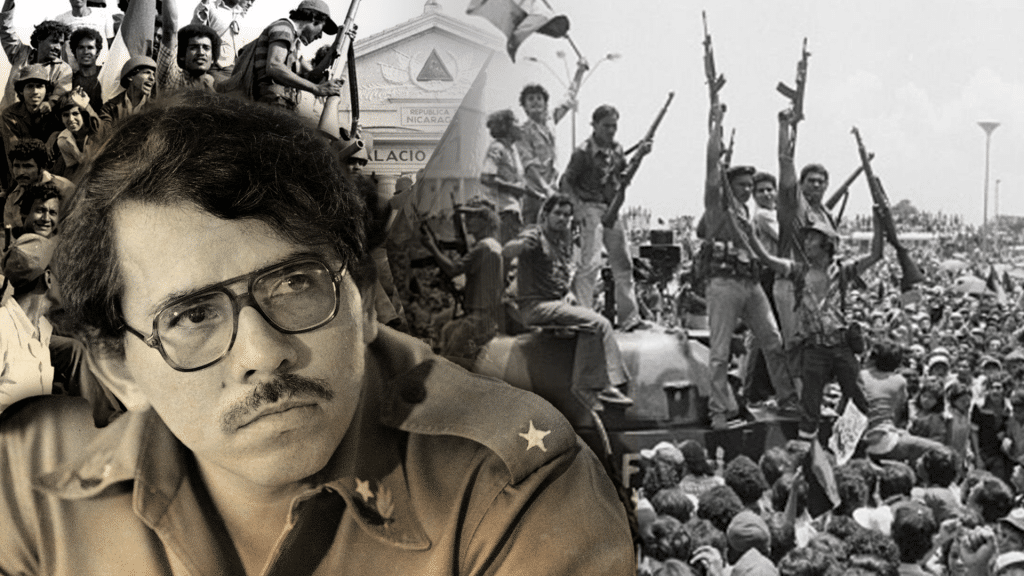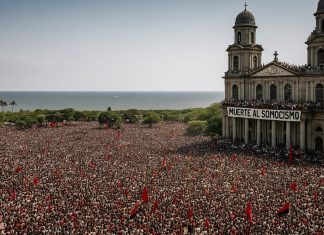
In international forums and as official policy, Nicaragua has fostered an anti-colonialist character, denouncing colonial and neocolonial practices by Europe and the United States.
However, it is not surprising that Nicaragua advocates a sovereign claim of its interests, added to an implicit internationalist spirit in the character of the Sandinista Revolution, due to the fact that the Central American country has been intervened on numerous occasions by European nations and by the United States, addition the wars and cruel dictatorships, a morale of resistance that has been exemplary in different parts of the world.
The Indigenous Resistance
The history of resistance in Nicaragua begins in 1523 with the battles waged by the caciques Diriangén and Macuil Miquitzli (Five Deaths in Nahuatl and popularly known as cacique Nicaragua), against the Spanish invaders, led by Gil González de Ávila.
According to the historian Antonio Esgueva, the affirmation that the Europeans were considered by the indigenous population as the reincarnation of their gods in Nicaragua was not true. “The phenomenon of considering Spaniards as superior beings or gods does not occur in Nicaragua. Gonzalo Fernandez de Oviedo introduces us to Diriangén saying that the Spanish were not braver than him”.
The resistance of the peoples living in the Caribbean was also tough, a territory that Spain could not access in its entirety. “Undoubtedly, the indomitable spirit of the original peoples who lived at the entrance of the mountains was the cause of the little intention shown by the Spaniards in the conquest of such remote regions”, says the historian Jaime Incer. Other important uprisings recorded during the colonial period, include Sutiava between 1681 and 1725, Sébaco in 1693 and that of the Boaco people, led by the cacique Yarrince.
Against the Nicaraguan indigenous resistance, the Spanish unleashed cruelty and violence, highlighting the conquerors, Pedrarias Dávila and Rodrigo de Contreras, as the bloodiest governors that the former province of Nicaragua had. In 60 years, the country’s indigenous population dropped from one million to just 10,000.
Monroe Doctrine and the beginning of North American imperialism
In 1823, the United States promoted the Monroe Doctrine, famous for the phrase «America for the Americans», where the power to influence the affairs of the American continent was attributed as a hegemonic power in contrast to the Europeans.
Thus, between 1856 and 1857 the National Anti-Filibuster War was unleashed, in rejection of the slave-owning aspirations undertaken by an army of southern American colonialists and who had the support of the United States government. Although at first the North American filibusters had the support of the local Nicaraguan oligarchies, little by little the national conscience began to manifest itself in the Nicaraguan patriots who offered resistance to the invading army.
Thus, the North Americans suffered several defeats throughout their attempted occupation of Nicaragua, the most famous of all being the Battles of San Jacinto, where 160 Nicaraguans, commanded by General José Dolores Estrada, defeated an invading force of 300 heavily armed men. Other examples of bravery during this action were the National Hero, Andrés Castro, and the Indigenous flecheros from Matagalpa.
U.S occupation from 1909 to 1912
In 1909 the United States overthrew the nationalist liberal José Santos Zelaya through the Knox Note. In 1912, five thousand marines landed in Nicaragua, establishing themselves as an occupation and intervention force in the internal affairs of the country and as guarantors of Washington’s interests in canal affairs and of the North American transnationals present in the country.
Here stands out General Benjamín Zeledon Rodríguez, a self-taught soldier, who on October 2, 1912, entrenched himself in the El Coyotepe fortress, on the outskirts of the city of Masaya, where he resisted firmly for two days.
US Colonel Joseph Pendleton urged Zeledon to surrender, receiving a response that would demonstrate the patriotic mystique of the Nicaraguan combatant.
“I trust that to you that I have read your note to which I allude and I have resisted believing that it was signed by an educated military […]But if unfortunately for the honor of the United States of North America, you and your bosses disregard the well-founded reasons that I adduced and they carried out their claims of attack, I will make with mine the resistance that the case demands […] and later, fall on you, your Chiefs and the very strong Nation to which you belong, the tremendous responsibilities that History will adduce you and the eternal shame, for having used their weapons against the weak who have been fighting to conquer the sacred privileges of the Homeland.
On October 4, 1912, Zeledon was killed by US artillery.
Sandino’s struggle: A giant of America
On September 2, 1927, General Augusto C. Sandino, together with 29 men, founded the Army for the Defense of National Sovereignty (EDSN). According to publications by the Nicaraguan Army, Sandino constitutes «the greatest Nicaraguan soldier of all time and together with the EDSN, contributed to the military sciences and military history of Nicaragua, a military political organization of the people away from subordination to political parties.»
“It was an irregular army with the characteristics of a regular army that reached a composition of 6,000 members. He implemented a novel long-term warfare strategy of attrition and resistance, comprised of irregular tactics. It combined the war of movements with the war of positions, and thus began «the guerrilla war» with which it reached an unprecedented global dimension by defeating and expelling from the national territory the powerful forces of the North American military intervention in 1933.
However, the relevance of Sandino was that in addition to being a nationalist patriot, the character and call of his struggle was also anti-imperialist and Latin American, managing to systematize the history of North American interventions as a domination plan to which the Latin American republics and patriots owed face it.
«You are in the obligation to make the people of Latin America understand that there should be no borders between us, and that we all have the precise duty to worry about the fate of each one of the peoples of Hispanic America, because we are all running the same fate before the colonizing and absorbing policy of the Yankee imperialists”, he stated.
From the Somocista Dictatorship to the Sandinista Revolution
The United States managed to implant the Somocista dictatorship for 47 years in the country, in line with its exploitative interests. In 1972, US investments exceeded 200 million dollars, equivalent to more than 1.4 billion dollars today.
In 1971, 85% of agricultural exports were produced by 1% of the farms, which belonged to large landowners and controlled 46% of the arable area in Nicaragua.
Illiteracy reached more than 50% of the population, and 56.8% of children under 5 years of age suffered from some degree of malnutrition. Life expectancy by 1979 was barely 55 years.
The World Bank defined the Nicaraguan situation as «a condition of life so limited as to be below any rational definition of human decency.»
When he fled the country in 1979, the fortune of Anastasio Somoza Debayle, the last of the dynasty, was more than 400 million dollars, equivalent to more than 1.6 billion dollars today.
But, how did Somoza, together with the local landowners, manage to dominate an entire country? Through the National Guard.
An army of 15,000 troops in a country that only had 1,400 doctors. The National Guard was also capable of being responsible for 35,000 deaths in just ten months. In addition to 100,000 injured people, 150,000 refugees, 40,000 orphans and 40% of the country’s population on the verge of starvation.
In 1979, finally, the people of Nicaragua, through the Sandinista National Liberation Front, led by Daniel Ortega Saavedra, managed to overthrow the Somoza dictatorship and finally democratize the country.
Sandinista Revolution: Example of Resistance
At the end of 1979, the first demonstrations by armed elements against the Revolution took place, calling themselves the Popular Anti-Sandinista Militias (MILPAS). In addition, former Somocista national guards formed in Miami, financed by the US government, the «September 15th Legion», which would come to be known as La Contra and which would have Honduran territory as its physical base.
For 10 years, Nicaragua faced a war of aggression that caused more than 60,000 deaths and generated large economic losses for the nation. However, Nicaragua has been the only country in the world to win a lawsuit against the United States in the International Court, on June 27, 1986, promoted by the Sandinista leader, Daniel Ortega, who governed in that period. As a result, and based on international law, the Central American country achieved:
- Reject the justification of collective self-defense held by the United States.
- Demonstrate that through training, equipment, weapons and supplies for the contras, the US intervened in the sovereign affairs of another State.
- Through multiple attacks against Nicaraguan territory, the United States acted against the Republic of Nicaragua
- The United States, through overflights, violated the sovereignty of the country.
- The United States committed acts contrary to humanitarian law.
- Force the United States to cease its hostile operations against Nicaragua.
- Oblige the United States to indemnify Nicaragua for the damages committed… among others.
The United States never complied with The Hague judgment.
Nicaragua today
Nicaragua’s current position is one of denunciation and resistance against the new colonialist methods, and those that still persist from previous centuries.
«Fathers of civilization» buying human beings, and then putting them on the ships where slaves transited from one continent to another, going from Africa to Europe, and from Europe to the United States because there, they needed a slave hand, and from the United States to the coasts from Africa to Europe, and from Europe to the Caribbean, where the islands were dominated by the British, by the French, by the Dutch,» said Daniel Ortega, president of Nicaragua during an act held in Managua in March 2023.
On the other hand, the Nicaraguan government before the United Nations, reaffirmed that «Nicaragua advocates full decolonization in our continent, so that our Latin America and the Caribbean is finally a territory free of colonialism and colonies, in all its forms and manifestations.”, in relation to the existence of overseas territories of the former colonialist nations today.
In the year 2022, the Government of Daniel Ortega, expressed before the United Nations Assembly the need to «bring closer the right of the peoples to a United Nations Organization that represents us all, and that does not submit to the designs of no imperialist power.
It may interest you: Daniel Ortega warns that slavery carried out by Europe cannot be forgotten
However, the Central American nation has also manifested the creation of a new world, made up of nations that were once subject, but that little by little have been resuming their own interests and have articulated them together with the interests of other peoples.
“The forces that are emerging in the different regions, political forces, State forces, forces of peoples that are emerging, defending respect for International Law and, therefore, the strengthening of multipolarity, that is what it is already uprising, that is what it has been uprising”, assured President Ortega during the reception of a delegation from Iran in February 2023.





